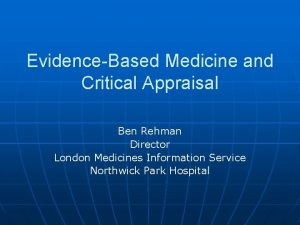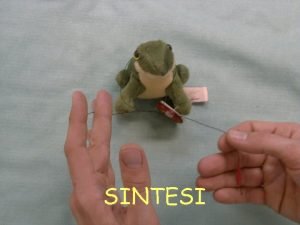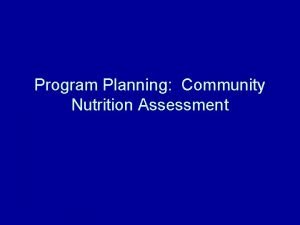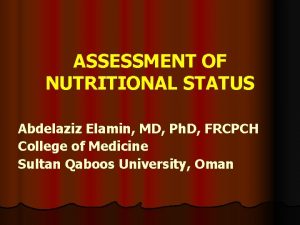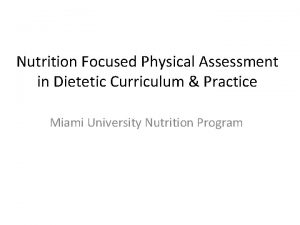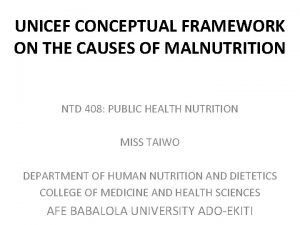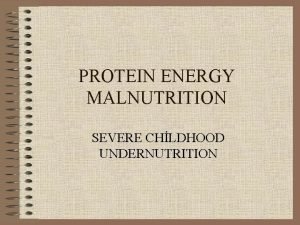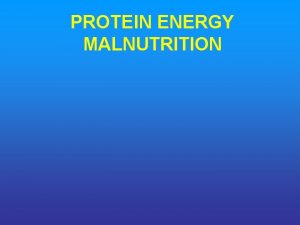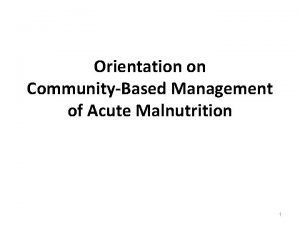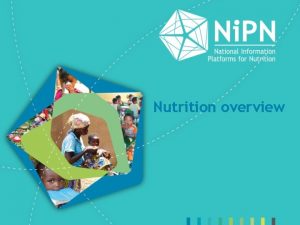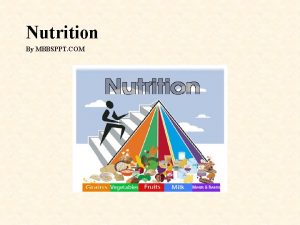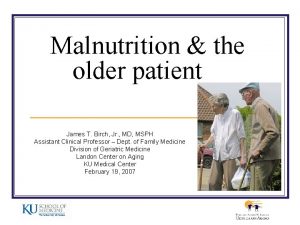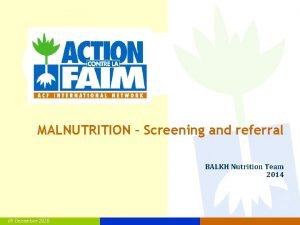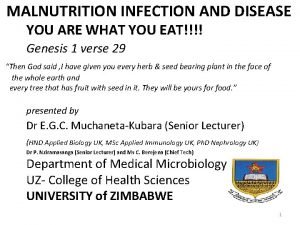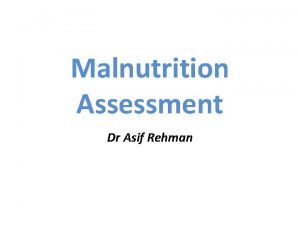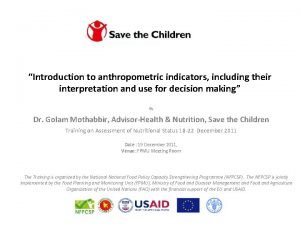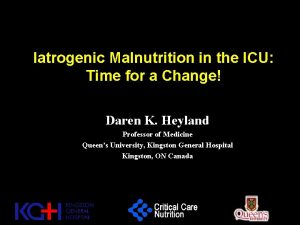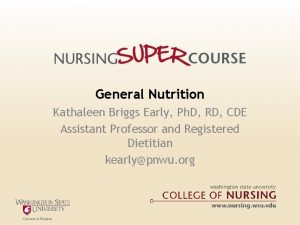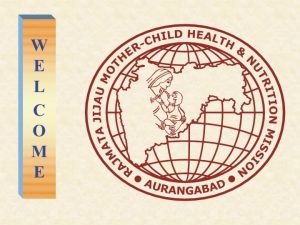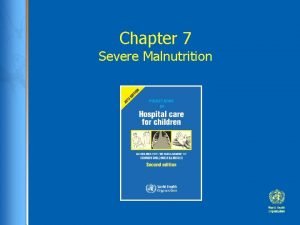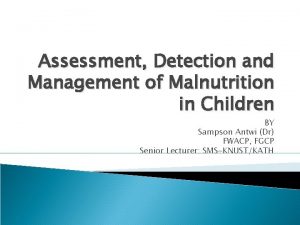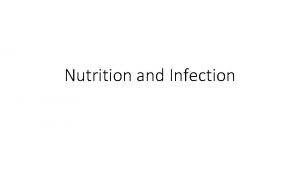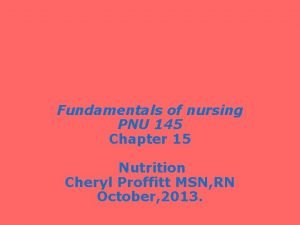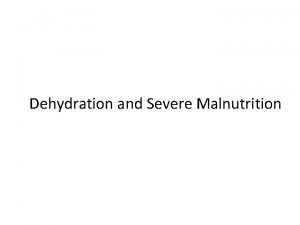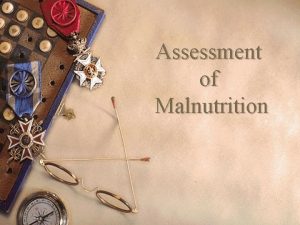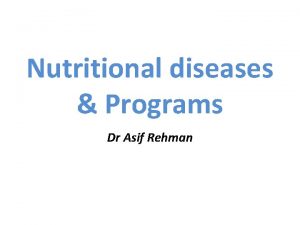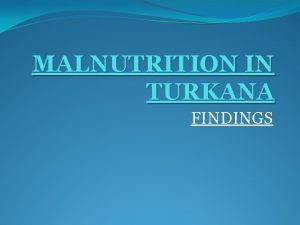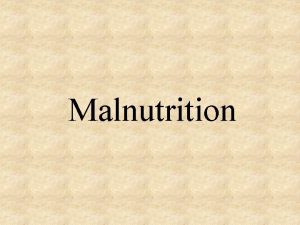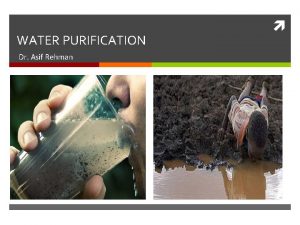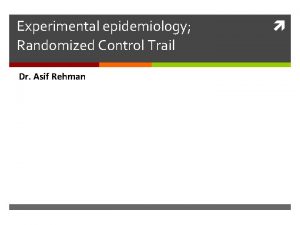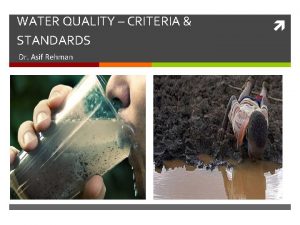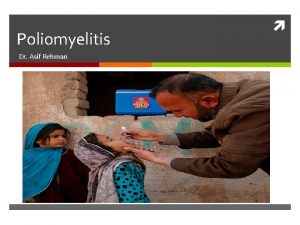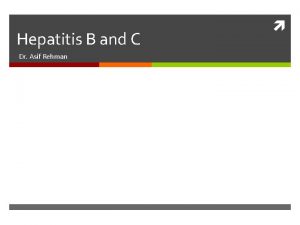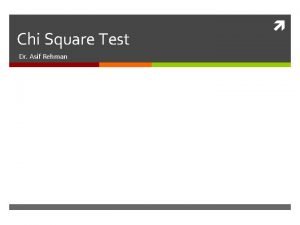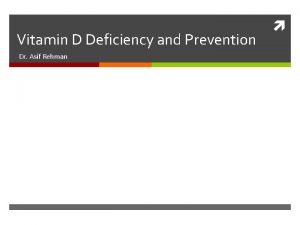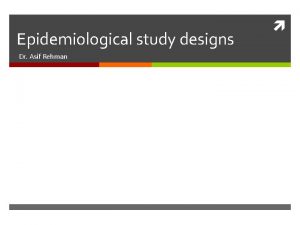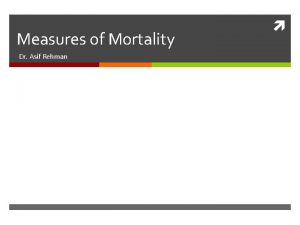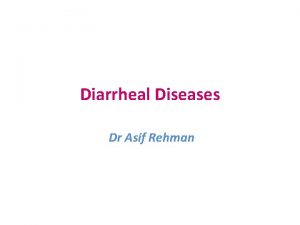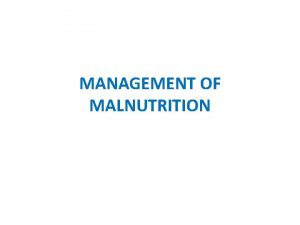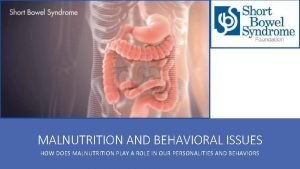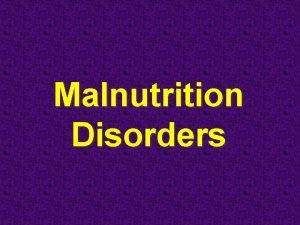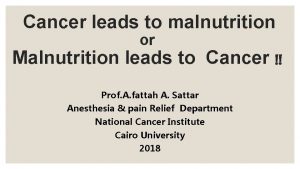Malnutrition Assessment Dr Asif Rehman Nutrition Nutrition may





































- Slides: 37

Malnutrition Assessment Dr Asif Rehman

Nutrition • Nutrition may be defined as “The science of food and its relationship to health” (K Park, 2012) • The word Nutrient is used for specific dietary constituents and are organic and inorganic complexes contained in food such as: a) Proteins b) Vitamins c) Minerals etc

Malnutrition Definition • A pathological state resulting from a relative or absolute deficiency or excess of one or more essential nutrient. Primary Malnutrition: • due to external factor like Food non availability Secondary malnutrition: • due to abnormal digestion/absorbtion/utelization

Forms of Malnutrition • Under nutrition: this results when insufficient food is eaten over an extended period of time e. g (PEM) • Over nutrition: Pathological condition resulting from consumption of excessive quantity of food over an extended period of time. • Imbalance: pathological state resulting from a disproportionate among essential nutrients with or without absolute deficiency of any nutrient. • Specific deficiency: relative or absolute lack of an individual nutrient e. g Vitamin A

Chronic malnutrition • It is the impair development of body function due to long term deficiency/excess in nutrient/energy intake. e. g. , stunting.

Protein Energy Malnutrition (PEM) PEM is defined as A range of pathological conditions arising from simultaneous deficiency of protein and calories and commonly associated with infection. • Occurs in both adults and children in developed countries • More common in children in developed countries Two main types 1. Kwashiorkor 2. Marasmus

Etiology of Primary Malnutrition • Failure of Lactation. • Improper Weaning Practices • Poverty • Food Taboos • 2 or more children under 5 years of age in same household • Death of Mother • Incompetent/ Ignorant Mother. • Lack of Family Planning

Etiology of Secondary Malnutrition • Lack of Immunization • Congenital Diseases: ASD, VSD, cleft palate etc. • Mal absorption: Celiac Disease, Lactose intolerance, Giardiasis, Cystic Fibrosis • Metabolic: Inborn errors of Metabolism, CRF, Renal tubular Acidosis etc. • Infections: Tuberculosis (very common in Pakistan)

Prevention of Malnutrition • Primary Prevention • Health Education to mothers about good nutrition and food hygiene through Lady Health Workers • Immunization of children. • Growth monitoring on Growth Charts specially of all children under 5 years of age • Secondary Prevention • Mass Screening of high risk populations, using simple tools like Weight for age or MUAC. • Tertiary Prevention • Good Nutritional Care, supplementary feedings and rehabilitation, counseling of mothers.

Nutritional Assessment Why? The purpose of nutritional assessment is to: • Identify individuals or population groups at risk of becoming malnourished. • Identify individuals or population groups who are malnourished. • To develop health care programs that meet the community needs which are defined by the assessment. • To measure the effectiveness of the nutritional programs & intervention once initiated.

Direct Methods of Nutritional Assessment These are summarized as ABCD • Anthropometric methods • Biochemical, laboratory methods • Clinical methods • Dietary evaluation methods (Ilyas)

Indirect Methods of Nutritional Assessment • These include three categories: • Ecological variables including crop production. • Economic factors e. g. per capita income, population density & social habits. • Vital health statistics particularly infant & under 5 mortality & fertility index. (CDC)

CLINICAL ASSESSMENT • It is an essential features of all nutritional surveys. • It is the simplest & most practical method of ascertaining the nutritional status of a group of individuals. • It utilizes a number of physical signs, (specific & non specific), that are known to be associated with malnutrition and deficiency of vitamins & micronutrients. e. g paleness, Goiter, spoon shape nails

Severe Palmer Pallor

Edema

Spoon shaped nail

Vitamin Function Source Deficiency Vitamin K Helps coagulation of blood Cabbage, cauliflower Delayed blood coagulation Vitamin B 1 Carbohydrate metabolism Legumes, nuts Beriberi, loss of appetite, fatigue Vitamin B 2 Forms parts of several enzymes system Liver, cheese, eggs Lips cracks at corner of the mouth, soreness of tongue Vitamin B 12 Participate in hematopoieses in nucleic acid synthesis Liver, Kidney Pernicious anaemia Vitamin C Regulates calcium metabolism Helps in healing Green veg, oranges, Scurvey, bleeding gums, dental caries, anaemia. Iron Spoon shape nails Iodine Goiter

Anthropometric measures 1. 2. 3. 4. 5. 6. 7. 8. Weight for age Height for age Weight for height Skin fold thickness Head circumference Hip waist ratio MUAC BMI

HEAD CIRCUMFERENCE Age Head Circumference

SKIN FOLD THICKNESS

Growth Chart

MUAC TAPE

How to Measure MUAC • Remove extra clothing that may cover the child’s left arm. • Calculate the midpoint of the child’s left upper arm • Straighten the child’s arm and wrap the tape around the arm at midpoint. • Inspect the tension of the tape on the child’s arm. • Record MUAC measurement.








ACUTE MALNUTRITION Types 1. Moderate Acute Malnourished (MAM) 2. Severely Acute Malnourished (SAM)

Acute Malnutrition, Indices and cutoffs Bilateral Pitting Oedema MUAC WFH z-score (WHO) SAM Present (+, +++) < 11. 5 cm < -3 MAM Not Present 11. 5 <12. 5 cm ≥ -3 and < -2

Body Mass Index BMI = Weight (kg)/Height (m²)

BMI (WHO - Classification) • • • BMI < 18 BMI 18 - 24. 9 BMI 25 - 29. 9 BMI >30 - 40 BMI >40 = Under Weight = Healthy weight range = Overweight (grade 1 obesity) = Obese (grade 2 obesity) = Very obese (morbid or grade 3 obesity)

Exercise 1. An adult weight is 86. 5 kg, height is 170 cm calculate BMI & interpret the results. 1. Write down the cutoff points of MUAC. 1. Write down at least 6 anthropometric measures for nutritional assessment.

Exercise 1. An adult weight is 86. 5 kg, height is 170 cm calculate BMI & interpret the results. 2. A 6 month old child having weight of 6 kg. Plot the graph on growth chart and interpret its results. 3. Write down at least 6 anthropometric measures for nutritional assessment.

THANK YOU
 Fasih ur rehman
Fasih ur rehman Dr waheed rehman
Dr waheed rehman Tahira rehman
Tahira rehman Abdur rahman chughtai
Abdur rahman chughtai Ben rehman
Ben rehman Minahil asif
Minahil asif Ltad evreleri
Ltad evreleri Dr asif hanif
Dr asif hanif Amir asif
Amir asif Sutura pds
Sutura pds Asif international
Asif international Asif əsgərov
Asif əsgərov Nutrition program planning
Nutrition program planning Direct method of nutritional assessment
Direct method of nutritional assessment Capillary refill
Capillary refill Focused gi assessment
Focused gi assessment Unicef conceptual framework
Unicef conceptual framework Gomez classification
Gomez classification Wellcome classification
Wellcome classification Moderate acute malnutrition
Moderate acute malnutrition What are the 4 types of malnutrition
What are the 4 types of malnutrition Iap classification of malnutrition
Iap classification of malnutrition Z score for malnutrition
Z score for malnutrition Malnutrition ppt
Malnutrition ppt Marasmus disease
Marasmus disease Malnutrition conclusion
Malnutrition conclusion Abcd of nutritional assessment
Abcd of nutritional assessment Anthropometric measurements ppt
Anthropometric measurements ppt Icd 10 ch
Icd 10 ch Iatrogenic malnutrition definition
Iatrogenic malnutrition definition Kwashiorkor and marasmus
Kwashiorkor and marasmus Conceptual framework of malnutrition
Conceptual framework of malnutrition Severe acute malnutrition case presentation
Severe acute malnutrition case presentation Baggy pants malnutrition
Baggy pants malnutrition Aspen criteria for malnutrition
Aspen criteria for malnutrition Malnutrition
Malnutrition Purpose of malnutrition
Purpose of malnutrition Fluid of choice in severe dehydration
Fluid of choice in severe dehydration




